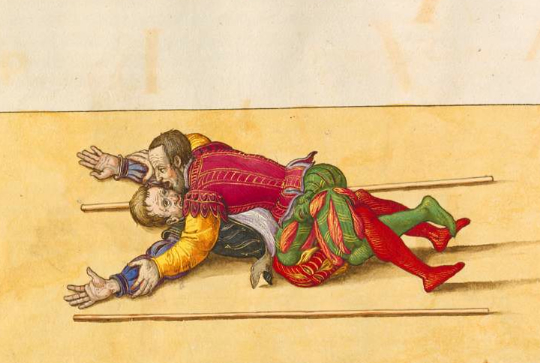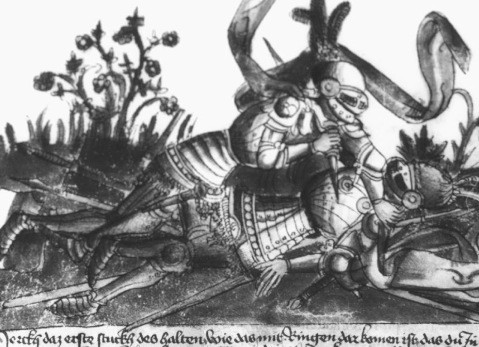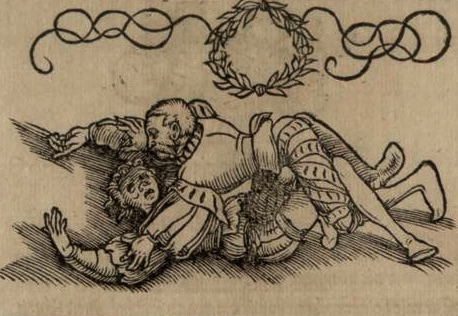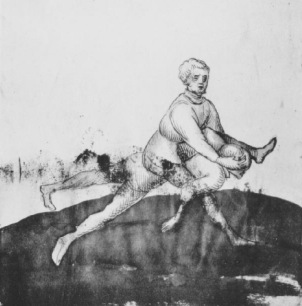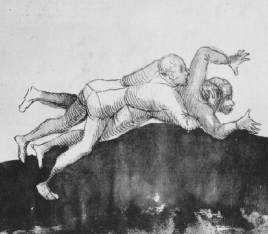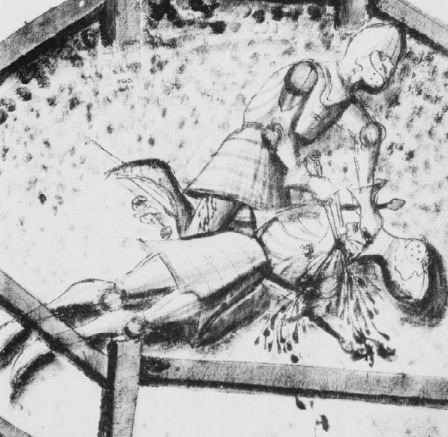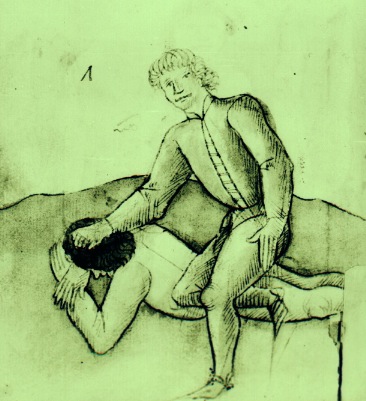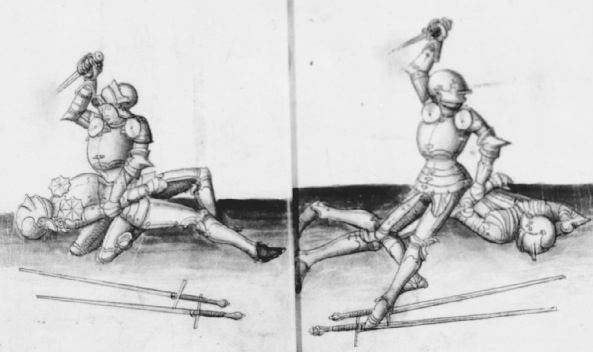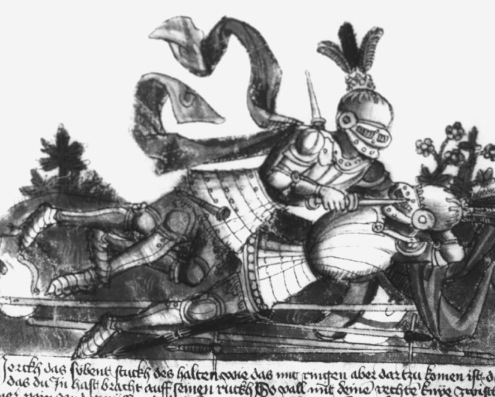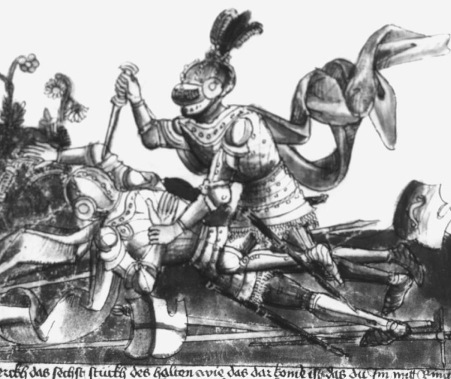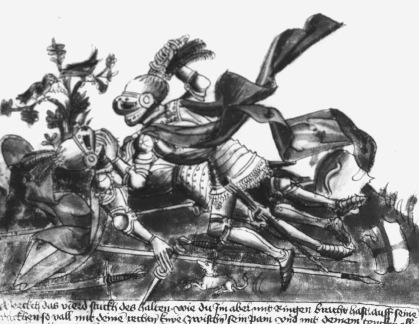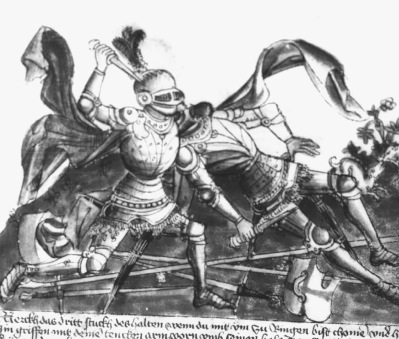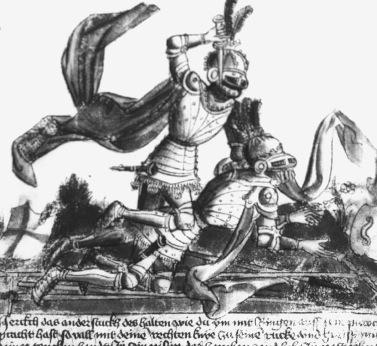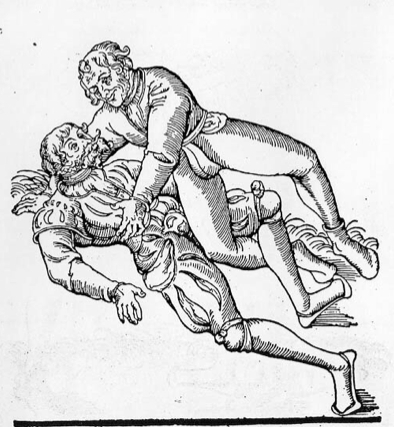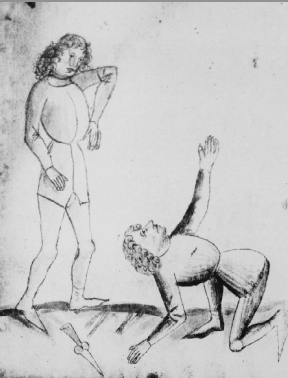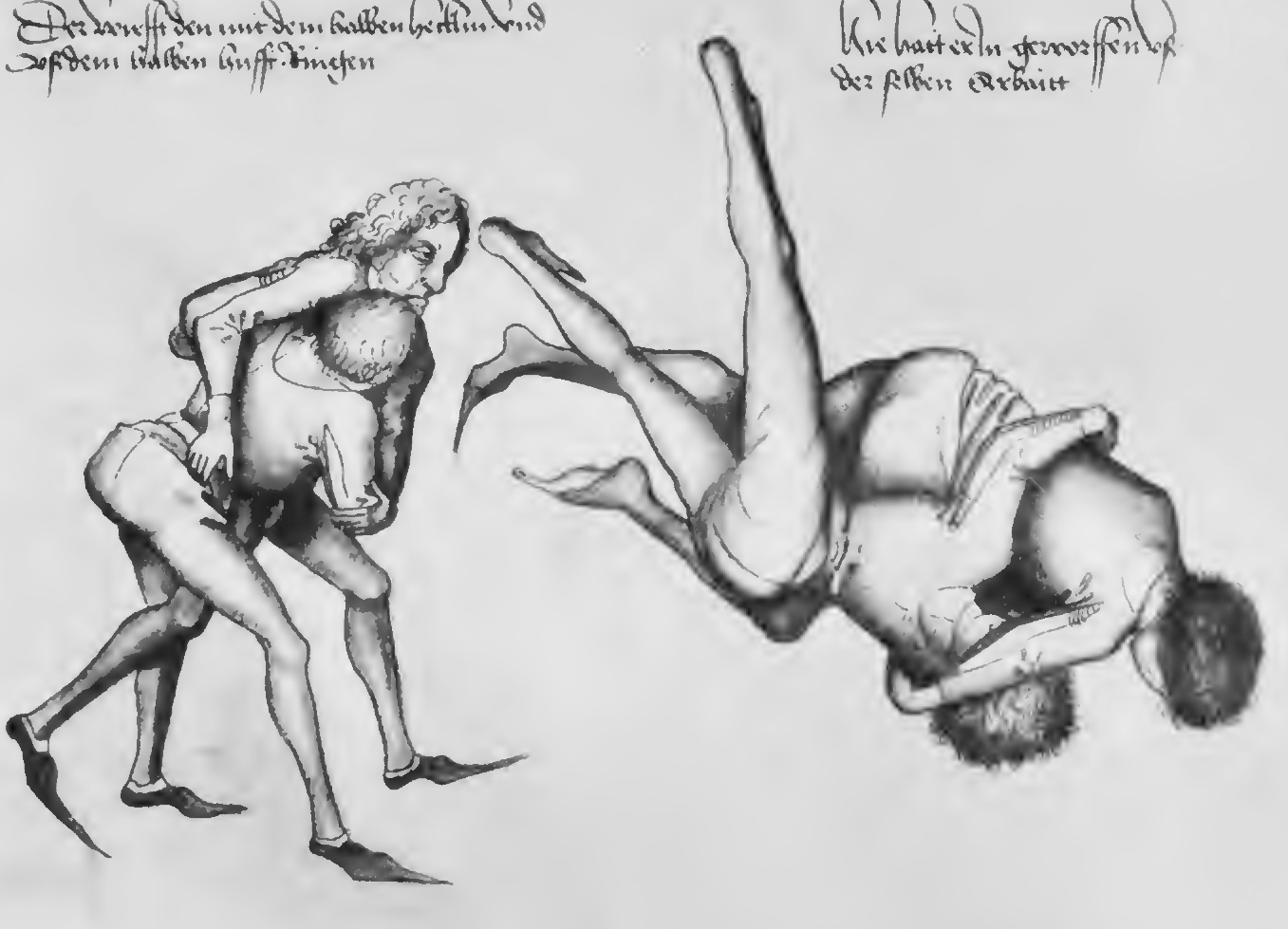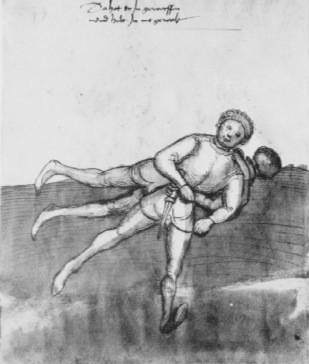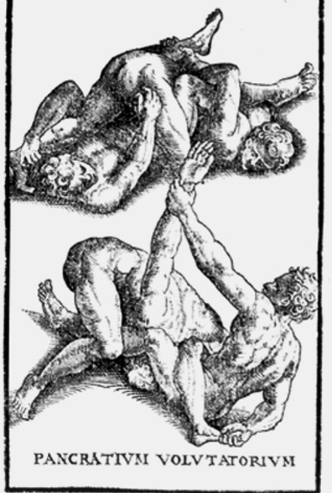 Where's
All the Ground Fighting? Where's
All the Ground Fighting?
Changing our perception of Renaissance unarmed combat
By
John Clements
ARMA Director
I
am not much of a grappler or wrestler and have always promoted staying
away from your opponent and using your weapon (even while emphasizing
to close and fight inside). I have, however, for many years prided myself
on specializing in disarms and trapping techniques, the skills of "sword-taking"
(Schwertnemen). Seizing and takedowns or throws have long been
primary in my opinion over wrestling. In pursuit of armed fighting arts
I have emphasized these teachings among my personal students. I have never
found this approach wanting (I can add that I have a well-earned reputation
for being hard to get a grip on).
Recently, while conversing with a respected European expert on combatives
and self-defense, currently consulting for the US military, I mentioned
how little ground fighting there really was in the Fechtbuchs—despite
many people wanting to now think of Kampfringen as modern jujutsu. My
colleague said he was not at all surprised by my findings. (Curiously,
incidents among US combat personnel in Iraq and Afghanistan have produced
some critical controversy over the predominance of teaching ground fighting
skills within military combatives programs... Too much emphasis on going
to the ground for submissions as athletic exercise. Go figure. I said
the same thing years ago.)
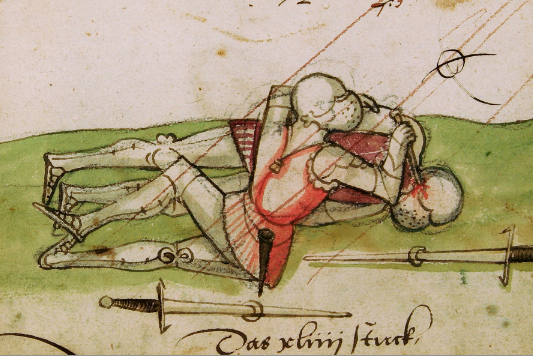 Following
this discussion I decided to take a more careful look through my extensive
collection of unarmed combat images from Medieval and Renaissance artwork,
and sure enough... I can say: Show me the ground fighting! Where
is it? If ground fighting was particularly valued then it is noticeably
under-represented in the very historical examples we rely upon. This realization
came to my attention when I recently tried to gather all the ground fighting
images from the Fechtbuchs for a presentation to a MMA group, but I could
only find a tiny few. I looked through more than a thousand images
from our historical source literature (especially the major German and
Italian works) and all I can find within the fighting manuals of the 15th
and 16th centuries is about a dozen total examples showing unarmed fighters
on the ground. (!) In fact, when looking through ancient artwork
on Pankration and Roman unarmed combat sports and fighting arts, I could
only find a handful of ground fighting depictions there as well. Following
this discussion I decided to take a more careful look through my extensive
collection of unarmed combat images from Medieval and Renaissance artwork,
and sure enough... I can say: Show me the ground fighting! Where
is it? If ground fighting was particularly valued then it is noticeably
under-represented in the very historical examples we rely upon. This realization
came to my attention when I recently tried to gather all the ground fighting
images from the Fechtbuchs for a presentation to a MMA group, but I could
only find a tiny few. I looked through more than a thousand images
from our historical source literature (especially the major German and
Italian works) and all I can find within the fighting manuals of the 15th
and 16th centuries is about a dozen total examples showing unarmed fighters
on the ground. (!) In fact, when looking through ancient artwork
on Pankration and Roman unarmed combat sports and fighting arts, I could
only find a handful of ground fighting depictions there as well.
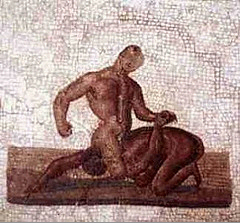 Although
my examination was not an exhaustive search, to be sure, virtually
every image of unarmed fighting techniques within Renaissance martial
arts source teachings, a combatant is displayed either being thrown
down or being held upright. Even then, most of the ground fighting images (as
the example collected here reveal) reflect restraining or mounting
in place an opponent who has already been taken down. Excluding a few unsurprising images
of a prone figure in armor being dispatched by a dagger (such as in the
Gladiatoria and Solothurner Fechtbuchs), I have so far found noticeably
few exceptions — not counting for repetitions of the same technique appearing
again in later editions, such as the various versions of Hans Talhoffer's
work. Although
my examination was not an exhaustive search, to be sure, virtually
every image of unarmed fighting techniques within Renaissance martial
arts source teachings, a combatant is displayed either being thrown
down or being held upright. Even then, most of the ground fighting images (as
the example collected here reveal) reflect restraining or mounting
in place an opponent who has already been taken down. Excluding a few unsurprising images
of a prone figure in armor being dispatched by a dagger (such as in the
Gladiatoria and Solothurner Fechtbuchs), I have so far found noticeably
few exceptions — not counting for repetitions of the same technique appearing
again in later editions, such as the various versions of Hans Talhoffer's
work.
As has been pointed out, we do not see in the majority of the
images actual ground "fighting" (that is, the fallen opponent
successfully defending themselves or wrestling on their back),
but rather ground "killing."
We find only a few ground techniques depicted in the early German works, showing
limb locks or pinning holds, but ground fighting is not present in the
teachings of major Masters of Defence such as Fiore De Liberi, Filippo
Vadi, Achille Marozzo, etc. What does appear makes up a tiny fraction
of the art and associated text of unarmed combat. One edition of Hans
Talhoffer's Fechtbuch depicts just one out of tens, while two other
editions have just three. Two ground fighting images appear in Leckuechner's
messer manual, one in the Codex Wallerstein, and three in an anonymous
15th century German work. Paulus Kal's work from the 1470s contains
just three. The late 15th century work by Hans Wurm, a whole manuscript
on unarmed fighting, shows not a single one. There also appears only
one sample plate in the work of Hans Lebkommer (c.1500). Out of more than
80 plates on Ringen moves in Fabian von Auerswald's 1539 book there
is only a single solitary image showing both fighters on the ground. Even
the largest collection of Ringen teachings, that of Paulus Hector Mair's
immense compendia (c.1545), has only two or three ground images out of
tens on grappling. None appear in Albrecht Duerer's unarmed techniques
either. Not a single image of ground fighting is shown in the many Ringen
plates of Joachim Meyer's famous treatise of 1570. The same can be
said of the late 17th century unarmed teachings of Nicholaes Petter.
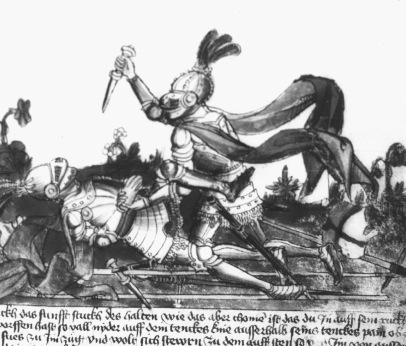 Sure
enough, the whole point of Ringen is to get your opponent down while you
remain free and upright so that you can use your weapon on him (which
is what a major portion of the illustrated armored combat sequences within
the sources ultimately end with). Or else you give yourself the chance
to escape. Those times that combatants are illustrated as being lifted
or tossed they no doubt will surely end up grounded, but this does not
mean you are supposed to then jump on them. No, rather, they are
finished as a result of the slam, and if not, then you employ your weapon
or flee. So, while the German schools of defence have the concept of Unterhalten("holding
down") as a component of wrestling, and one major Italian
source expresses a preference not to roll around on the ground but to
safely stand up and throw your man. In his fighting treatise, the
master Fiore dei Liberi wrote consistently of throwing his man to the
ground, but never of joining him there. Sure
enough, the whole point of Ringen is to get your opponent down while you
remain free and upright so that you can use your weapon on him (which
is what a major portion of the illustrated armored combat sequences within
the sources ultimately end with). Or else you give yourself the chance
to escape. Those times that combatants are illustrated as being lifted
or tossed they no doubt will surely end up grounded, but this does not
mean you are supposed to then jump on them. No, rather, they are
finished as a result of the slam, and if not, then you employ your weapon
or flee. So, while the German schools of defence have the concept of Unterhalten("holding
down") as a component of wrestling, and one major Italian
source expresses a preference not to roll around on the ground but to
safely stand up and throw your man. In his fighting treatise, the
master Fiore dei Liberi wrote consistently of throwing his man to the
ground, but never of joining him there.
We must remember, virtually everyone carried a dagger back then and often
you might be facing multiple opponents, or be encumbered by armor. The
last thing you wanted to do is grapple while laying prone where your eyes
can be gouged, your groin ripped, and the adversary maim you by biting
— you know, all the things that occur in life and death combat
situations but are omitted and forbidden in the controlled conditions
of wrestling sports and MMA. Go figure.
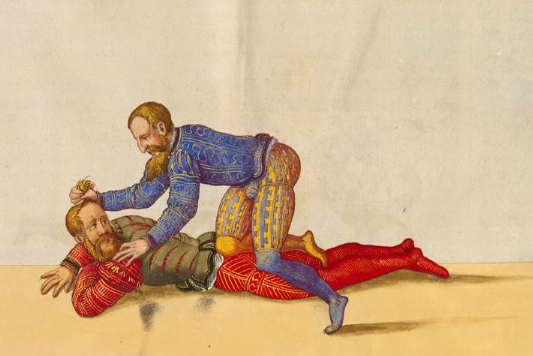 I
consulted with a certain former student about this and he too concurred
with the obsession for grappling among many modern self-defense methods. As
a 14-year police SWAT veteran, he noted how the last thing he wants to
do is go to the ground with a suspect where he might then become vulnerable
to a hidden weapon, as well as clawing, biting, etc., not to mention having
his own firearm taken from him. Why do it when he can instead use his
stick or employ a move that takes the person down? I
consulted with a certain former student about this and he too concurred
with the obsession for grappling among many modern self-defense methods. As
a 14-year police SWAT veteran, he noted how the last thing he wants to
do is go to the ground with a suspect where he might then become vulnerable
to a hidden weapon, as well as clawing, biting, etc., not to mention having
his own firearm taken from him. Why do it when he can instead use his
stick or employ a move that takes the person down?
Something I have observed over the last decade's emergence of historical
European martial arts study is that practitioners who come from a judo/jujutsu
or Greco-Roman wrestling background will in the middle of free-play make
a mental decision to stop fencing and start grappling. They fail to connect
the skill sets together as simply "fighting." So, they typically
get hit in that instant where they are making the mental shift between
the two. The same phenomenon occurs notoriously among classical fencers
and those who have never practiced any unarmed skills. When you close
with them and make body contact they are easily overcome because they're
still hopelessly stuck in "swordplay" mode. Watching
my students the past few years who are skilled grapplers learn the
difficulty of employing the simplest of unarmed techniques against a
skilled swordsman in fencing bouts has been illuminating.
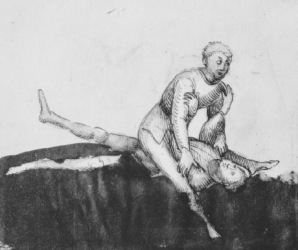 I've
also noticed a tendency whereby too many enthusiasts approach the idea of Ringen
as just a wrestling match where they come to the clinch then try to go
straight to the ground and roll around until someone submits. The
reality of serious combat however is that a fighter should want to
avoid entanglements. When you can get the opponent off his feet while
you remain upright it's a tremendous advantage. You don't then willingly
join him there. We might recall that both Vincentio Saviolo and George
Silver each complained in the 1590s that poor rapier fencing led to the
fighters going quickly to the ground, which they each considered to be
something inferior to effective fighting. I've
also noticed a tendency whereby too many enthusiasts approach the idea of Ringen
as just a wrestling match where they come to the clinch then try to go
straight to the ground and roll around until someone submits. The
reality of serious combat however is that a fighter should want to
avoid entanglements. When you can get the opponent off his feet while
you remain upright it's a tremendous advantage. You don't then willingly
join him there. We might recall that both Vincentio Saviolo and George
Silver each complained in the 1590s that poor rapier fencing led to the
fighters going quickly to the ground, which they each considered to be
something inferior to effective fighting.
Wrestling is the basis of all fighting, as the grandmaster Liechtenauer
and the master Fiore dei Liberi both tell us. But I believe this does
not mean its techniques are the heart of the matter, but only its central
idea that whether you are armed or not the very core of all combat reduces
to closing with and leveraging the opponent. As Dr. Sydney Anglo pointed
out in his seminal work on the martial arts of Renaissance Europe, the
role of wrestling in knightly martial culture was viewed in contradictory
ways during the 14th to 16th centuries. I suspect now the issue might
have been one of the difference between Kampfringen — grappling
techniques that are about throws, take downs, disarms, and unarmed skill
versus weapons—as opposed to wrestling as a sport of going to the
ground to achieve a submission hold — something to be avoided in
a life and death encounter.
 Ground
fighting without weapons in our source works is very limited — despite
the impression some practitioners now have that it was or is especially
important. And when it is present with weapons, it is in the context of
finishing off an opponent that has been taken down. That's certainly not
the kind of ground fighting people do now in mixed martial arts practice.
Thus, while it is not in dispute that there is "some" ground
fighting in the source teachings, what I am proposing is that this "some"
is actually quite small and really not all that significant. I believe
that it was uncommon and not the intended goal of Ringen training. Those
who believe differently are certainly free to provide evidence that contradicts
this view. Ground
fighting without weapons in our source works is very limited — despite
the impression some practitioners now have that it was or is especially
important. And when it is present with weapons, it is in the context of
finishing off an opponent that has been taken down. That's certainly not
the kind of ground fighting people do now in mixed martial arts practice.
Thus, while it is not in dispute that there is "some" ground
fighting in the source teachings, what I am proposing is that this "some"
is actually quite small and really not all that significant. I believe
that it was uncommon and not the intended goal of Ringen training. Those
who believe differently are certainly free to provide evidence that contradicts
this view.
I tell my students do all the grappling and wrestling you like and you
will not learn the value of fencing. But do fencing right and you will
learn the value of Ringen. For myself, I have never studied wrestling
or grappling arts. Instead, my skills and all I know about it, I have
learned from my practice of historical fencing — a craft which
I approach without any artificial post-Renaissance separation between
armed and unarmed teachings.
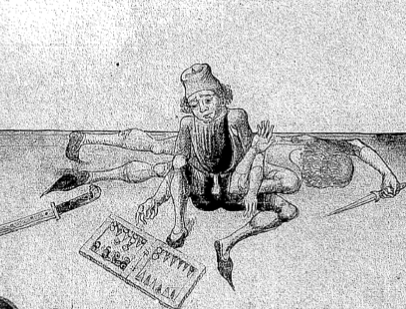 There
is no denying the utility and value of skills in ground fighting as being
beneficial for a martial artist. But in combat, standing up when your
opponent is on the ground is arguably superior to anything else. All
the more so when deadly weapons are involved. I believe our historical
source teachings reflect this. The only time this is not true is when
you make fighting into an unarmed contest or game where you want to force
an opponent to tap out. (If you doubt it, try wrestling sometime
against someone carrying a small dagger in their belt. See how quickly
things end.) There
is no denying the utility and value of skills in ground fighting as being
beneficial for a martial artist. But in combat, standing up when your
opponent is on the ground is arguably superior to anything else. All
the more so when deadly weapons are involved. I believe our historical
source teachings reflect this. The only time this is not true is when
you make fighting into an unarmed contest or game where you want to force
an opponent to tap out. (If you doubt it, try wrestling sometime
against someone carrying a small dagger in their belt. See how quickly
things end.)
So, we are left with no choice but to challenge those advocating ground fighting
in RMA (Renaissance martial arts) to show us the evidence, textural or
iconic, from our source teachings. Where's all the ground fighting?
October 2009
End Note: I think
ground-work as a whole is just overrated—a result of the pendulum
of modern popular martial arts having excluded grappling in favor of "kick-boxing"
styles for so long that when the Brazilians came along and wiped out fighters
in the mid-1990s everyone soon realized their deficiencies. Nowadays,
things are back where they should be for modern unarmed self-defense:
people acknowledge that you need to be able to fight standing up, to throw
or block blows when necessary, to face multiple attackers, and more importantly
to effect take downs and throws (or prevent them being used on you). When
you over emphasize ground-work because it's popular you are a less well-rounded
fighter—whether modern or historical, armed or unarmed. I think
that historical lesson has been relearned out of our recent military conflicts.
In historical fencing studies, the immediate lethality of weapons in close-combat
encounters teaches you right away to avoid purposely going to the ground
with your opponent. I think our ancestors knew this. And it's even more
so when modern firearms are involved.
|



